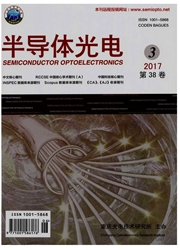

 中文摘要:
中文摘要:
根据微波传输线理论,结合集总元件构造的复合左/右手传输线,分别实现了负介电常数材料和负磁导率材料,并进一步制作了由这两种单负材料交替组成的一维光子晶体。仿真与测量结果显示,该光子晶体结构可产生零有效相位带隙。若结构参数能同时满足阻抗匹配条件和相位匹配条件,零有效相位带隙将消失。若两个匹配条件无法同时被满足,零有效相位带隙将始终存在,带隙中心处在阻抗匹配频率。此外,在阻抗匹配频率处,若结构参数偏离相位匹配条件越大,零有效相位带隙将越宽且越深,通过此规律可实现对带隙的调制。
 英文摘要:
英文摘要:
According to the theory of microwave transmission line, the permittivity-negative and permeability-negative materials were realized and then one-dimensional photonic crystals constituted by alternating single-negative materials were fabricated by using composite right/left handed transmission lines with lumped elements. Simulation and measurement results show that such photonic crystals may produce zero-effective-phase (zero-Фeff) gap. When the structure parameters satisfy both impedance-match and phase-match conditions simultaneously, the zero- Фeff gap closes. When the two matching conditions cannot be satisfied at the same time, the zero- Фeff gap always exists and its center locates at the central frequency. Furthermore, at the impedance-match frequency, the greater the phase-match condition deviates from being satisfied, the bigger and wider the zero-Фeff gap will be. Such properties can be used to control to the zero- Фeff. gap.
 同期刊论文项目
同期刊论文项目
 同项目期刊论文
同项目期刊论文
 Defect modes merging in one-dimensional photonic crystals with multiple single-negative material def
Defect modes merging in one-dimensional photonic crystals with multiple single-negative material def Unusual transmission bands of one-dimensional photonic crystals containing single-negative materials
Unusual transmission bands of one-dimensional photonic crystals containing single-negative materials Omnidirectional and independently tunable defect modes in fractal photonic crystals containing singl
Omnidirectional and independently tunable defect modes in fractal photonic crystals containing singl 期刊信息
期刊信息
